| Pages:
1
2 |
Bedlasky
International Hazard
    
Posts: 1239
Registered: 15-4-2019
Location: Period 5, group 6
Member Is Offline
Mood: Volatile
|
|
Here are photos of hypomanganate solution for five days storage.
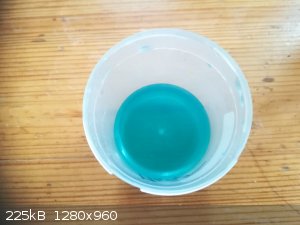 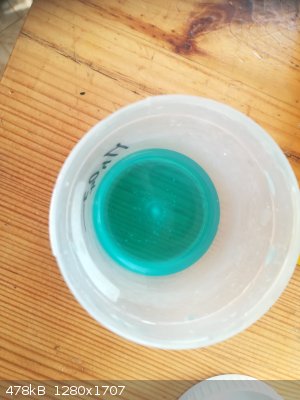 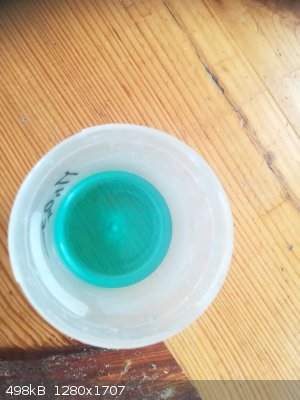 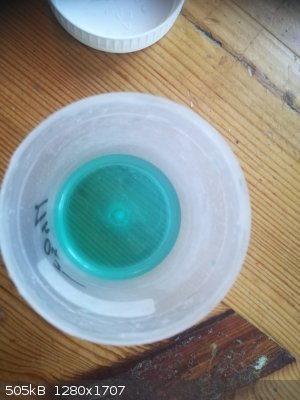 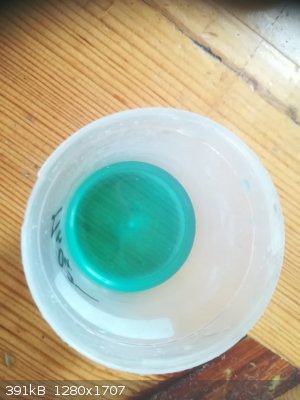
|
|
|
woelen
Super Administrator
        
Posts: 8012
Registered: 20-8-2005
Location: Netherlands
Member Is Offline
Mood: interested
|
|
Great experiments and good home science!
This type of experiments I definitely will try myself soon. I have all the required chemicals and equipment, so I can certainly try this.
If you have a stronly alkaline solution, then you may try adding a barium salt. Barium hydroxide is soluble fairly well, but barium manganate(V) is
said to be insoluble. This may be a method to isolate (albeit a very small amount) of a solid manganate(V) and observe its color.
|
|
|
Bedlasky
International Hazard
    
Posts: 1239
Registered: 15-4-2019
Location: Period 5, group 6
Member Is Offline
Mood: Volatile
|
|
I haven't any barium salt so I can't try this  . In my country isn't very e-shops
which sell chemicals to people without business (for example I don't know where I buy manganese sulfate or chrome alum which are common chemicals). . In my country isn't very e-shops
which sell chemicals to people without business (for example I don't know where I buy manganese sulfate or chrome alum which are common chemicals).
|
|
|
Pumukli
National Hazard
   
Posts: 705
Registered: 2-3-2014
Location: EU
Member Is Offline
Mood: No Mood
|
|
In my country mangane(II)-sulphate can be freely bought in farmer supply stores! It is used as micronutrient for plants! Of course, you can buy Zn-,
Fe-, Cu-sulphates as well, along with ammonium-molibdate!
|
|
|
Bedlasky
International Hazard
    
Posts: 1239
Registered: 15-4-2019
Location: Period 5, group 6
Member Is Offline
Mood: Volatile
|
|
Thanks for suggestion. On the internet I didn't find it but I try stores in my city. Zn, Fe and Cu sulfates isn't problem find. Sodium molybdate is
available too.
|
|
|
Lion850
National Hazard
   
Posts: 517
Registered: 7-10-2019
Location: Australia
Member Is Offline
Mood: Great
|
|
Not sure if anyone still monitors this old thread, but some time ago I reacted a teaspoon aluminium power with a teaspoon of potassium permanganate on
a tile out in the garden. It made a nice flash, lots of sparks, and afterwards I saw green specs among the bits leftover on the tile. When I washed
the tile with the garden hose there was beautiful green runs from these green specs. I wonder if these green specs were potassium manganate? I'll
investigate further when I am back home again.
|
|
|
S.C. Wack
bibliomaster
    
Posts: 2419
Registered: 7-5-2004
Location: Cornworld, Central USA
Member Is Offline
Mood: Enhanced
|
|
Quote: Originally posted by Texium (zts16)  | | I was thinking that allowing a basic solution of potassium manganate to evaporate would leave me with nice green crystals sitting in an
ultra-concentrated NaOH solution that doesn't evaporate because of its deliquescence, but instead it looks like it oxidized to permanganate despite
being in strongly basic solution. |
Are you sure (if you remember) the hydroxide wasn't converted to carbonate? Did you try the freezer first?
|
|
|
Texium
Administrator
       
Posts: 4580
Registered: 11-1-2014
Location: Salt Lake City
Member Is Offline
Mood: PhD candidate!
|
|
Hmm... 5 years ago... I honestly have no idea at this point. At the time that I did these experiments, I wasn't taking good notes, and the results are
pretty dubious. I wouldn't necessarily agree with some of the conclusions that I came to now.
|
|
|
Hugh
Harmless

Posts: 1
Registered: 12-11-2019
Member Is Offline
|
|
I made sodium hypomanganate for the first time a few days ago, used a totally different method based on the one used when it was first discovered. I'd
tried various aqueous routes but they never seemed to work, although I haven't yet tried the one from Bedlasky shown here.
I melted about 10 grams of sodium nitrite by heating in a beaker using a Bunsen and then added about 250mg of manganese dioxide.This was then stirred
with constant heating for about 10 minutes and much of the manganese dioxide dissolved to give a dark grey-brown solution, but a lot remained
suspended. Next I added about 2.5g of sodium hydroxide pellets and heated the mixture gently to keep it molten with occasional stirring until a dark
blue-green solution formed. This took about 15 minutes. A little of the manganese dioxide still remained suspended, but not much. The mixture was left
to cool and formed a blue-grey solid that got steadily more blue-green and then bright blue once it was completely cool. This took about an hour as it
kept producing heat as it cooled. Photos are attached.
If you do this then be careful when you add the sodium hydroxide pellets as it spits like mad (go slowly). The mixture has also eaten the end of a
glass rod and has corroded the surface of a pyrex beaker. Sometimes the beaker will crack during cooling, so plan for this. I had great fun dripping a
little of the mixture onto paper towel and watching it ignite on contact with a single drop, so again take care.
Sometimes the product is somewhat greener than in the photos, generally when I heat it more aggressively or use too little sodium hydroxide, so be
prepared to experiment a bit as the recipe above could be refined further for better results. The product decomposes to a dark grey-brown mess after a
day or two.
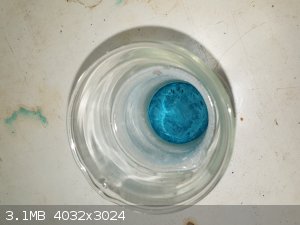 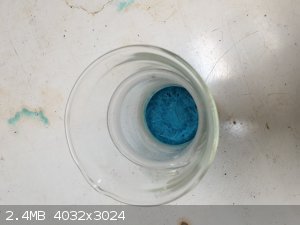
|
|
|
Fery
International Hazard
    
Posts: 1015
Registered: 27-8-2019
Location: Czechoslovakia
Member Is Offline
|
|
Quote: Originally posted by Bedlasky  | I haven't any barium salt so I can't try this  . In my country isn't very e-shops
which sell chemicals to people without business (for example I don't know where I buy manganese sulfate or chrome alum which are common chemicals). . In my country isn't very e-shops
which sell chemicals to people without business (for example I don't know where I buy manganese sulfate or chrome alum which are common chemicals).
|
this shops sells to chem fans too, no need to have business ID
Ba(NO3)2
https://www.kovyachemie.cz/dusicnan-barnaty/
Mn
https://www.kovyachemie.cz/kovy-spony-a-kousky/mangan-elektr...
they sell other chemicals too like BaCO3 and even BaO2
I'm buying from this shop for 15 years already, very good prices, quick delivery - usually the second day after order, at most 2 days (if you order
during night :-D)
|
|
|
Bedlasky
International Hazard
    
Posts: 1239
Registered: 15-4-2019
Location: Period 5, group 6
Member Is Offline
Mood: Volatile
|
|
Hugh: Great experiment! You used method of Hermann Lux from 1946?
If you want your product stable for longer time, try it store in bag with anhydrous CaCl2. CaCl2 will absorb moisture and your product won't
disproportionate.
Thank you for this shop! 
|
|
|
Bedlasky
International Hazard
    
Posts: 1239
Registered: 15-4-2019
Location: Period 5, group 6
Member Is Offline
Mood: Volatile
|
|
About my preparation of hypomanganate is also on my webpage in english and in czech.
Since today are hypomanganates also on sciencemadness wiki.
|
|
|
Bedlasky
International Hazard
    
Posts: 1239
Registered: 15-4-2019
Location: Period 5, group 6
Member Is Offline
Mood: Volatile
|
|
Hi.
I tried yesterday if manganates and hypomanganates react with certain sugars, carboxylic acids and sodium dithionite. Here are observations:
Citric and oxalic acid: No reaction
Tartaric acid and sodium dithionite: Firstly reduction in to hypomanganate, then in to hydrated manganese dioxide (reduction of hypomanganate with
tartaric acid is slow).
Sucrose: Slow reduction in to hydrated manganese dioxide.
Sorbitol and ascorbic acid: Quick reduction in to hydrated manganese dioxide.
Glucose, fructose: This reaction is interesting. With glucose firstly brown manganese dioxide is obtain. But after some time colour of solution slowly
fades until it is completly colourless. With fructose it is simmilar but decolorization is much much faster. I was wonder why was solution colourless.
This is usually caused by Mn(II) - but divalent manganese is present in basic conditions as Mn(OH)2 which is quickly oxidized by air in to MnO(OH). So
I decided to try dissolve some glucose and fructose in 4%NaOH and add some MnCl2 solution. Fructose solution turned brown for a second but quickly
decolorized. In glucose solution MnO(OH) was formed, but after some time it dissolved in glucose in to the colourless solution. At the surface of both
solutions was brown ring due to aeral oxidation. It looks that Mn(II) forms with glucose and fructose in alkaline media complexes which are in excess
of sugar stable to oxidation by air.
I'll later post some photos.
[Edited on 9-2-2020 by Bedlasky]
|
|
|
Bedlasky
International Hazard
    
Posts: 1239
Registered: 15-4-2019
Location: Period 5, group 6
Member Is Offline
Mood: Volatile
|
|
Hi.
Here are photos from experiment.
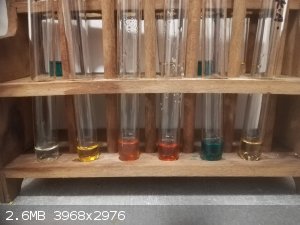
Reduction of manganate. From left: glucose, fructose, sucrose, tartaric acid, citric acid, ascorbic acid.
Test tube with fructose reduction is orange due to decomposition products of fructose in strongly alkaline solution.
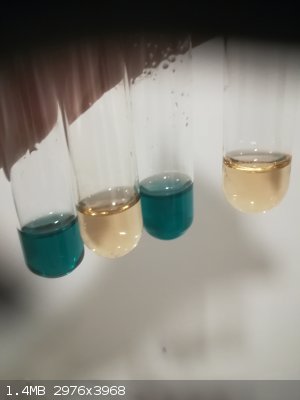
Reduction of manganate. From left: nothing (just manganate solution for comparison), dithionite, oxalic acid, sorbitol
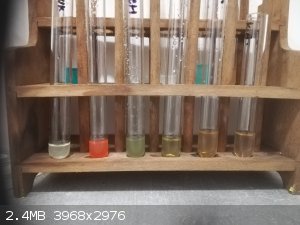
Reduction of hypomanganate. From left: glucose, fructose, sucrose, tartaric acid, citric acid, ascorbic acid.
Test tube with fructose reduction is red due to decomposition products of fructose in strongly alkaline solution.
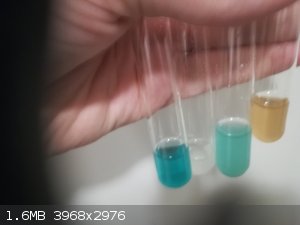
Reduction of hypomanganate. From left: nothing (just hypomanganate solution for comparison), dithionite, oxalic acid, sorbitol
[Edited on 11-2-2020 by Bedlasky]
|
|
|
EthidiumBromide
Harmless

Posts: 42
Registered: 27-9-2020
Member Is Offline
Mood: Effervescent
|
|
After discovering this thread a few months ago and successfully preparing my first hypomanganate sample with the thiosulfate procedure by Bedlasky, I
went on to do some additional hypomanganate experimentation, using different reducing agents and reaction conditions. I wanted to see the colour a
very concentrated hypomanganate solution would have. Trying to maximize the reduction efficiency of manganate, hoping to minimize any contamination
with residual manganate and bring out the bluest blue of hypomanganate.
My starting material was a rather concentrated solution of manganate (roughly 0.1M), made by adding KMnO4 to a boiling 10M NaOH solution:
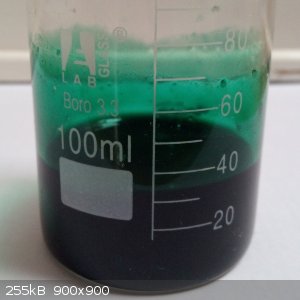
A small amount of this solution was diluted in 2M NaOH to have a sample for comparison later.
When the solution completely cooled down, it was put in the freezer, to get it very cold. After about 2 hours of sitting in the freezer, it was taken
out. It had a syrupy/pasty consistency, as some of the hydroxide precipitated out. But this wasn't a bad thing, as I wanted to limit any decomposition
as much as possible and I would assume a solid NaOH lattice would help to further stabilize hypomanganate at such a high concentration.
A refrigerated solution of 0.25M Na2SO3 (Na sulfite) in 5M NaOH was added in roughly a 1.5 molar excess of Na2SO3 in regards to manganate. This was
thoroughly stirred to ensure proper mixing of Na2SO3 with the manganate paste. It was placed back in the freezer. After 1 hour it was taken out, with
the following result:
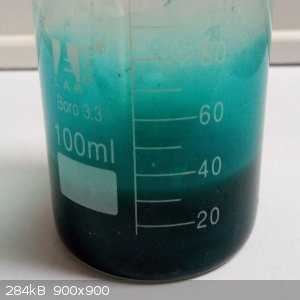
Comparing the colour of the thin layer of liquid on glass with the starting solution of manganate, it is very clearly more blue.
An amount of this new material (approximately the same as with manganate from before) was diluted in refrigerated 10 M NaOH. The resulting diluted
solutions of manganate and hypomanganate were compared:
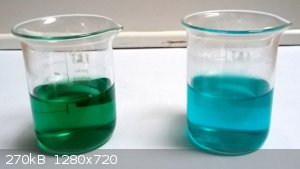
To be frank, my camera doesn't pick up intense greens to well, so the above image doesn't accurately reproduce the colours. The manganate was much
deeper and saturated in reality, and the hypomanganate was also slightly deeper in colour. I transfered both solutions into test tubes, to examine the
colour when it's made less intense, which resulted in a far more accurate representation of both colours. I judged both the photo and the actual view
of the test tubes, and this time the difference was much less significant, so you can take my word that this is photo is the closest in terms of
colour reproduction out of all the ones I have taken.
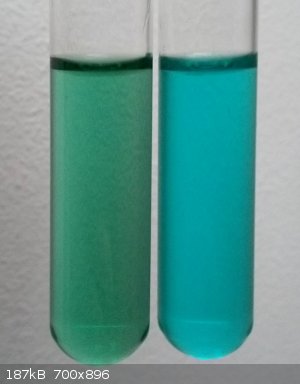
----------------------------------
I also tried what has been suggested by others - adding an alkalized solution of barium salt to the hypomanganate. I dissolved Ba(NO3)2 in 5 M NaOH. I
eyeballed it without paying attention to molarity. I then diluted some of the thick hypomanganate "syrup" in 10 M NaOH. I added some of the Ba
solution to the diluted hypomanganate and left it in the refrigerator for 4 hours to see if I get a precipitate. Here was the result:
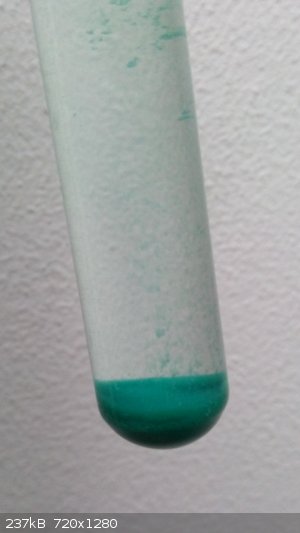
Important was making the Ba nitrate solution fairly alkaline itself. I tried with making a saturated solution in pure water and adding a really small
amount of this saturated solution to the hypomangate, but the hydroxide concentration becomes insufficient and the Ba hypomanganate precipitate
disproportionates, rapidly turning a murky brownish green, unlike Ba manganate which becomes sufficiently stable once it is precipitated.
Also, it should be considered that other solids are in the precipitate, such as BaSO3, BaSO4, BaCO3, etc. So perhaps this isn't the colour of "pure"
Ba3(MnO4)2, but since it is a lot lighter in colour then what you get when precipitating manganate with Ba, I'll claim this as a success in obtaining
at least some barium hypomanganate.
I intent to try precipitating a larger amount and perhaps collecting it to dry out, but seeing how easily it disproportionated once the hydroxide
concentration dropped, I doubt that this is possible at all.
------------------------------------
Here is one more photo of just the hypomanganate, from an earlier run where thiosulfate was used as the reducing agent, according to Bedlasky's
method, except again I've made a concentrated hydroxide "syrup" to create an enviroment that minimizes any chance of hypomanganate decomposition. The
material, diluted in 10 M NaOH, exactly matches the "sky-blue" colour description found in some literature. Very pretty colour.
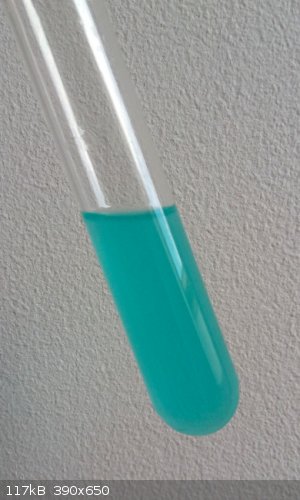
------------------------------------
I mainly did this small project out of abundance of spare time, but also for disambiguation purposes, so if someone wants to also prepare
hypomanganate in the future, they will know what to look for to see if the method worked. Manganate is often described as a bluish-green, so it might
be tricky to tell the difference between manganate and hypomanagate (especially in very small concentrations) if all you know is that hypomanagate is
supposed to be blue in colour. I hope the above photos give a better idea of the difference between the respective colours of MnO42- and
MnO43-. And also, there's not enough photos that show the very rare hypomanganate, so I'm glad I could provide additional ones here.
Many people have tried to produce hypomanganate without success, but it's perfectly possible to do it - the key is keeping low (preferrably ice cold)
temperatures, as hypomanganate very easily disproportionates with increased temperature. And copious amounts of NaOH or KOH at every stage of the
experiment, which should be taken into proper safety considerations. Also it is important to use a slight excess of reducing agent, but not too much,
because hypomanganate will be reduced further if too much reducing agent (such as sulfite) is used. Thiosulfate seems to be mild enough to not
overreduce it, however.
I would also like to try the method of dissolving MnO2 in a molten mixture of NaNO2 and NaOH and see if I can extract the hypomanganate by dissolving
it in cold 10 M NaOH and see if the resulting colour of solution and Ba precipitate is any different. I just need to find a suitable vessel to contain
the molten NaNO2/NaOH mixture.
[Edited on 10-12-2020 by EthidiumBromide]
|
|
|
Texium
|
Threads Merged
10-12-2020 at 13:05 |
Bedlasky
International Hazard
    
Posts: 1239
Registered: 15-4-2019
Location: Period 5, group 6
Member Is Offline
Mood: Volatile
|
|
EthidiumBromide: Very nice results!
Quote: Originally posted by EthidiumBromide  | | Manganate is often described as a bluish-green, so it might be tricky to tell the difference between manganate and hypomanagate (especially in very
small concentrations) if all you know is that hypomanagate is supposed to be blue in colour. |
Hypomanganate and manganate have very different colours. Manganate is green even in very dilute solution without any bluish tint. Hypomanganate is
turqoise and have less intense colour than manganate. There really isn't problem to tell if you have hypomanganate or manganate.
Quote: Originally posted by EthidiumBromide  | | Also it is important to use a slight excess of reducing agent, but not too much, because hypomanganate will be reduced further if too much reducing
agent (such as sulfite) is used. Thiosulfate seems to be mild enough to not overreduce it, however. |
Depending on reducing agent. But excess of sulfite or thiosulfate really doesn't reduce hypomanganate in to manganese dioxide. This can do just H2O2,
dithionite and certain organic compounds (look at my posts above). Btw. sulfite is even milder reducing agent than thiosulfate. Thiosulfate can reduce
Mo(VI) in to Mo(V), while sulfite can't reduce Mo(VI).
Another good and selective reductor for preparation of hypomanaganate is acetone. You can use it in excess, because hypomanganate doesn't react with
acetone.
Quote: Originally posted by EthidiumBromide  | I also tried what has been suggested by others - adding an alkalized solution of barium salt to the hypomanganate. I dissolved Ba(NO3)2 in 5 M NaOH. I
eyeballed it without paying attention to molarity. I then diluted some of the thick hypomanganate "syrup" in 10 M NaOH. I added some of the Ba
solution to the diluted hypomanganate and left it in the refrigerator for 4 hours to see if I get a precipitate. Here was the result:
Important was making the Ba nitrate solution fairly alkaline itself. I tried with making a saturated solution in pure water and adding a really small
amount of this saturated solution to the hypomangate, but the hydroxide concentration becomes insufficient and the Ba hypomanganate precipitate
disproportionates, rapidly turning a murky brownish green, unlike Ba manganate which becomes sufficiently stable once it is precipitated.
Also, it should be considered that other solids are in the precipitate, such as BaSO3, BaSO4, BaCO3, etc. So perhaps this isn't the colour of "pure"
Ba3(MnO4)2, but since it is a lot lighter in colour then what you get when precipitating manganate with Ba, I'll claim this as a success in obtaining
at least some barium hypomanganate.
I intent to try precipitating a larger amount and perhaps collecting it to dry out, but seeing how easily it disproportionated once the hydroxide
concentration dropped, I doubt that this is possible at all. |
Didn't you have problems with precipitating Ba(OH)2 from strongly alkaline Ba(NO3)2 solution?
Somewhat purer Ba3(MnO4)2 can be prepared by heating BaO with MnO2 at 900°C. But I propose easier way to make purer Ba3(MnO4)2. Reduce manganate
solution using acetone - acetone is oxidised in to acetate and carbonate. So you don't have in solution sulfates, sulfites, thiosulfates etc.
|
|
|
Lion850
National Hazard
   
Posts: 517
Registered: 7-10-2019
Location: Australia
Member Is Offline
Mood: Great
|
|
I tried to make barium manganate more or less according to the procedure in the attached document, following the below extract but with reduced
quantities. But I had to use more water for the BaCl2 to get it to dissolve; not sure if the below is a typo or whether it was supposed to remain in
suspension:
Attachment: Convenient Routes to Ba Permanganate.pdf (80kB)
This file has been downloaded 335 times
"118.5 g of potassium permanganate was dissolved in 1.5 L of water,
then the solution was mixed with 183 g of BaCl2.2H2O (in 45 ml
H2O), 30 g of NaOH (in 130 ml H2O) and 15 g of KI (in 60 ml
H2O). The mixture was boiled for 10 min, decanted, then the precipitate
obtained was washed 10 times with distilled water and
dried at 110 °C. Yield is 161 g. Analysis of the product was performed
by the method of Schlesinger [9]. Composition of the dried
product was 66.3 % of BaMnO4, 13.9 % of MnO2 and 19.8 % of
water."
- 23.9g KMnO4 in 300g water in beaker, heat and stir
- 36.3g BaCl.2H2O in 100g water in separate beaker, heat to near boiling to fully dissolve
- 6.2g NaOH in 25g water in separate beaker
- 3g KI in 12g water in separate beaker
- KMnO4 solution on stirring hotplate. Add BaCl2 solution.
- Add NaOH solution.
- Add KI solution.
- Dark solution. Heat to boil and boil (took some time) and boil for 10minutes.
Note: The attached mentioned 10 minutes boiling, but for larger quantities. I kept the same boiling time, but did wonder whether I should have
shortened the time.
- Deep purple coloured solution, dark ppt. Diverge from procedure and try to vacuum filter: big mess and my vacuum pump also decided to stop working
at that point!
- Scratch all of the dark ppt (which stained the beaker dark green) into a 2 litre beaker.
- Add 1.5 litre water. Stir 10 minutes. Leave to settle for one hour.
- Very dark ppt with purple supernatant solution - similar to a very dilute KMnO4 solution color.
- Repeat the above 2 steps a total of 6 times. Thus, in total "washed" with 9 litre of water.
- Not much change in the color of the ppt or the supernatant solution, after all the washing. Not sure if some of the barium manganate decomposes to
permanganate with excess water thus the constant purple color of the supernatant liquid?
- On steam bath. Dry some 6 hours till weight of the product remained constant at 26.2g Very dark black-blue product, see photo.
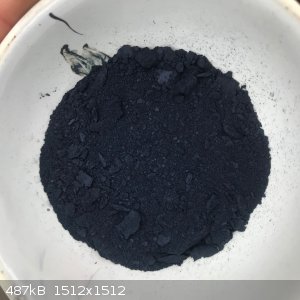
The attached reference says it cannot be avoided to have around 14% of MnO2 in the final product, following this method. Whether I have more than that
I do not know. Wikipedia says the color or barium manganate can be "light blue to dark blue and black" which means the color alone does not
necessarily say a lot.
I did some very simple tests with acids, mainly in the process of cleaning everything:
- With concentrated or slightly dilute HCl it gives a brown ppt, when heated with either concentrated or diluted HCl the brown ppt dissolves and the
solution eventually becomes clear. Plus a faint chlorine smell.
- With dilute H2SO4 there are some bubbles and a brown ppt, at room temp.
- With concentrated HNO3 there was an interesting observation: a while 'smoke' comes off which has no smell.
|
|
|
Bedlasky
International Hazard
    
Posts: 1239
Registered: 15-4-2019
Location: Period 5, group 6
Member Is Offline
Mood: Volatile
|
|
Very nice result Lion850! I always think that barium manganate is green  . .
If you want to do some analysis of your product, try chelatomeric determination of Ba (ammoniacal buffer pH = 10, eriochrome black T as indicator).
Firstly dissolve barium manganate in sulfuric acid, filter, washed well filter paper, neutralize, add buffer and indicator and titrate with 0,01M
EDTA.
|
|
|
Bedlasky
International Hazard
    
Posts: 1239
Registered: 15-4-2019
Location: Period 5, group 6
Member Is Offline
Mood: Volatile
|
|
I did today some spectroscopic study of MnO4n- anions in UV-VIS region using cca 0,8mM solution of permanganate, manganate and
hypomanganate.
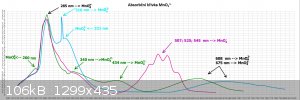
All anions have common peak with maximum at 285 nm.
Manganate and hypomanganate have similar peaks in the range 540-800 nm. Manganate peak is shifted more to the left with 608 nm absorbition maximum.
Hypomanganate have maximum at 675 nm.
Permanganate have typicall "finger tips" peak in the range 450-600 nm.
Manganate have typicall peak in the range 410-480 nm with maximum at 434 nm.
Hypomanganate have typicall sharp and tall peak in the range 310-320 nm with maximum at 316 nm.
There are also some small peaks for manganate with maximums at 260 and 340 nm and for hypomanganate with maximum at 321 nm.
|
|
|
Bezaleel
Hazard to Others
  
Posts: 444
Registered: 28-2-2009
Member Is Offline
Mood: transitional
|
|
Nice Absorbční Křivka 
Very interesting to see how part of the spectrum changes, whereas the peak around 285 nm stays virtually the same.
How did you record these? Do you have a spectrometer yourself?
|
|
|
Bedlasky
International Hazard
    
Posts: 1239
Registered: 15-4-2019
Location: Period 5, group 6
Member Is Offline
Mood: Volatile
|
|
I did it in my job, there is a spectrophotometer with VIS and UV lamps.
|
|
|
Lion850
National Hazard
   
Posts: 517
Registered: 7-10-2019
Location: Australia
Member Is Offline
Mood: Great
|
|
I had another go at potassium manganate. By boiling potassium permanganate in potassium hydroxide. I got the green product as a ppt / suspension, as
can be seen in the below photo.
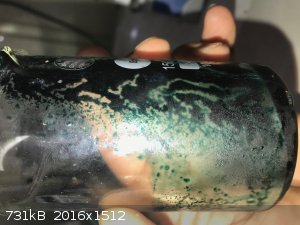
But I got stuck trying to filter it off. Plan was to filter it and then press dry the obtained green crystals between filter papers, and bottle it
still slightly wet with KOH. Problem, which I should have foreseen!, is that it reacts with the filter paper and decomposes. So I stored the wet
product, best I can do until I can filter it.
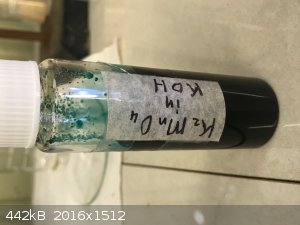
Any suggestion for filtering this product will be appreciated.
|
|
|
Bedlasky
International Hazard
    
Posts: 1239
Registered: 15-4-2019
Location: Period 5, group 6
Member Is Offline
Mood: Volatile
|
|
These highly oxiditing compounds can be filtered using glass filter crucible. Problem is, that your solution is highly alkaline. If you have your
manganate in cca 10% KOH, it shouldn't be a problem, but 30% KOH or something like that probably destroy glass frit.
I filtered sodium orthoperiodate through glass filter crucibles, solution contained cca 15g of unreacted NaOH/250ml and filteres are fine.
|
|
|
| Pages:
1
2 |